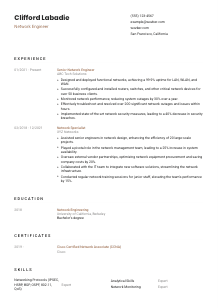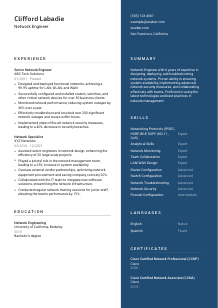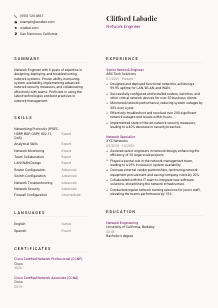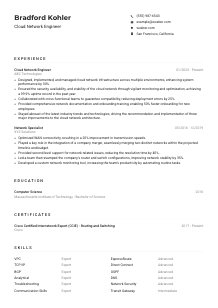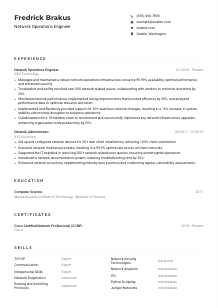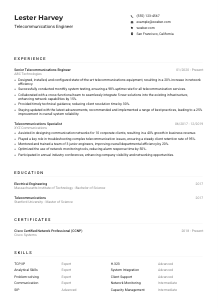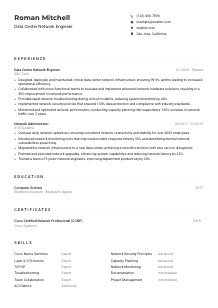Network Engineer Resume Example
Wiring networks, but your resume seems to lag? Delve into this Network Engineer resume example, structured with Wozber free resume builder. Learn how to frame your connectivity skills to mesh seamlessly with job requirements, propelling your career faster than a high-speed connection!
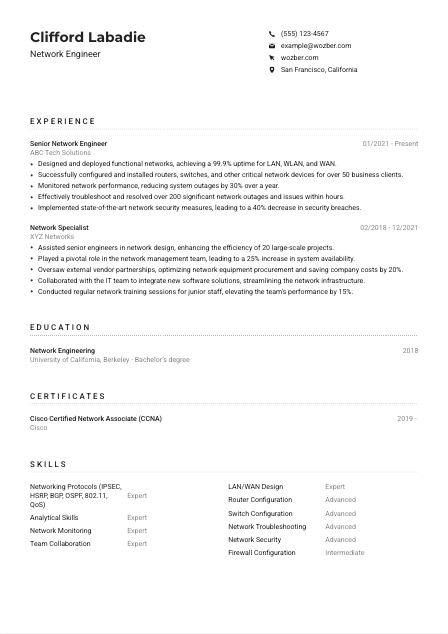
How to write a Network Engineer resume?
Greetings, aspiring Network Engineer! With today's job market more competitive than ever, standing out is not just commendable; it's essential. Your resume is not merely a document; it's a reflection of your professional journey and capabilities. Leveraging the power of Wozber free resume builder, this guide is specially crafted to walk you through the steps of creating a resume that resonates with the specific intricacies of a Network Engineer role.
Ready to embark on this resume crafting adventure? Let's gear up to transform your resume into a beacon that signals your unmatched expertise to potential employers.
Personal Details
First impressions last, and the Personal Details section of your resume is where this journey begins. Tailoring this section to the Network Engineer position ensures your resume communicates the right message from the get-go. Let's dive into optimizing your personal details to align like a well-configured network with your job application.
1. Your Name: The Network ID
Consider your name the hostname of your professional network—clear and prominent. Opt for a professional and legible font, perhaps a tad larger than the rest, ensuring it makes the right first impression.
2. Job Title: Signal Your Intent
Placing the targeted job title, "Network Engineer", right beneath your name acts like a targeted beacon signal to the hiring manager. It quickly aligns your application with the role, clearly declaring your professional focus.
3. Essential Channels
Your contact information acts as the gateway for potential employers to reach out. Ensure your phone number is current and your email mirrors professionalism, sticking to a firstname.lastname@email format. These are direct lines to you; keep them clear and mistake-free.
4. Location: Network Node
"San Francisco, California" not only aligns with the job requirement but also assures employers of your proximity, eliminating any concerns regarding relocation. It's like confirming network compatibility in the initial handshake.
5. Digital Presence: Your Protocol
If applicable, including a LinkedIn profile could enhance your "digital handshake" with recruiters. Just ensure it's polished and reflective of your resume. This segment is your chance to show a bit more of who you are in the professional digital world.
Takeaway
Think of the Personal Details section as your resume's handshake – it initiates the connection. Craft it to be professional, succinct, and in sync with the Network Engineer role you're aiming for. It's your first step in ensuring your resume speaks the right professional dialect.





Experience
The Experience section is where your professional journey comes to life. It's your opportunity to demonstrate how your past roles have perfectly prepared you for the Network Engineer position. Let's navigate through constructing a compelling narrative of your experiences.
- Designed and deployed functional networks, achieving a 99.9% uptime for LAN, WLAN, and WAN.
- Successfully configured and installed routers, switches, and other critical network devices for over 50 business clients.
- Monitored network performance, reducing system outages by 30% over a year.
- Effectively troubleshoot and resolved over 200 significant network outages and issues within hours.
- Implemented state‑of‑the‑art network security measures, leading to a 40% decrease in security breaches.
- Assisted senior engineers in network design, enhancing the efficiency of 20 large‑scale projects.
- Played a pivotal role in the network management team, leading to a 25% increase in system availability.
- Oversaw external vendor partnerships, optimizing network equipment procurement and saving company costs by 20%.
- Collaborated with the IT team to integrate new software solutions, streamlining the network infrastructure.
- Conducted regular network training sessions for junior staff, elevating the team's performance by 15%.
1. Analyzing the Network Requirements
Initiate by dissecting the job posting, identifying keywords like 'network design,' 'deployment,' 'troubleshooting,' and any specific protocols mentioned. These are the signals you need to amplify in your resume.
2. Configuring Your Roles
Structure your experiences in reverse chronological order, with emphasis on roles that highlight your expertise in network engineering. Clearly state your position, the company's name, and the tenure to maintain clarity in your career timeline.
3. Deploying Achievement Packets
Detail your accomplishments in a way that mirrors the job requirements. For instance, if the job emphasizes 'network security measures,' describe how you've implemented security protocols or reduced security breaches, directly relating your experience to the job's needs.
4. Optimizing Through Quantification
Quantify your achievements wherever possible. Statements like 'reduced system outages by 30%' or 'achieved a 99.9% uptime for LAN, WLAN, and WAN' provide a tangible measure of your impact and expertise.
5. Filtering Relevant Protocols
Although you might have a wide range of skills, focus on those most relevant to the Network Engineer role. Prioritize experiences that showcase your understanding of networking protocols, system design, and troubleshooting.
Takeaway
Your experience section is your professional broadcast, transmitting your qualifications and suitability for the Network Engineer role. With each bullet point, reassure the hiring manager that you're not just qualified; you're the candidate they've been searching for. Tailor, quantify, and confidently showcase your professional journey.
Education
Even the most complex networks rely on fundamental building blocks. Similarly, your education forms the foundational layer of your professional credentials. Let's look at fine-tuning your education section to align with the Network Engineer position.
1. Identifying Core Modules
Focus on the specific degree requirement highlighted in the job post, such as 'Bachelor's degree in Network Engineering.' This aligns your educational background with the initial filters of the role's requirements.
2. Structuring the Network Layer
Maintain a clear and hierarchical format by listing your degree, field of study, the educational institution, and graduation year. This clarity ensures easy navigation through your educational background.
3. Highlighting Relevant Firmware
Tailor the section by explicitly listing your Bachelor's in Network Engineering to directly match the job's educational criteria, reinforcing your candidacy at every opportunity.
4. Uploading Coursework Firmware
While not always necessary, for fresher candidates or specialized positions, mentioning relevant courses or projects can add depth to your educational background, showcasing a proactive approach to your profession.
5. Enhancing the Signal Strength
Consider adding any honors, extracurricular activities, or relevant projects that can differentiate you from other candidates. This is especially helpful for early-career professionals looking to make their mark.
Takeaway
Your education section is more than just a credential; it's a testament to your foundational expertise and learning path. Make it resonate with what the employer seeks. Every element of your resume, including your educational background, should project competence and readiness for the Network Engineer role.
Certificates
In the constantly evolving field of network engineering, certificates are like badges of honor, demonstrating your dedication to keeping your skills sharp and up-to-date. Here's how to illuminate your resume with your certification achievements.
1. Linking Certificates to Job Signals
Identify certificates mentioned in the job posting, such as 'CCNA or CCNP certification preferred.' These should be your priority in listing, as they directly reflect the employer's preferences.
2. Selecting the Right Badges
Rather than listing every certificate you've ever earned, focus on those most relevant to network engineering. This ensures your resume is tailored and concise, immediately showing value to the hiring organization.
3. Keeping Your Badges Current
Include the dates of your certifications, highlighting their currency. In a fast-paced field like network engineering, up-to-date knowledge is critical.
4. Continual Skill Refresh
The tech landscape is ever-changing, and so should your skill set. Actively pursue new certifications and learning opportunities, especially those that are directly beneficial to your role as a Network Engineer.
Takeaway
Certificates are not just accolades; they're evidence of your ongoing quest for knowledge and mastery in your field. They fortify your application, showing potential employers that you're not only qualified but continuously evolving. Align them closely with the job's demands for a resume that commands attention.
Skills
Your skills section is essentially the spec sheet of your professional capabilities. For a Network Engineer, this means highlighting your mastery over technical protocols and soft skills alike. Let's decode optimizing this essential part of your resume.
1. Syncing with Network Requirements
Begin with a deep dive into the job description, identifying both stated and implied skills required. Key skills like 'networking protocols' and 'analytical and diagnostic skills' should be front and center on your resume.
2. Prioritizing Relevant Specs
List skills that match up directly with the job description, ensuring you're seen as the perfect fit. Balance technical skills with soft skills to present yourself as a well-rounded candidate.
3. Organizing Your Toolkit
Structure your skills in a way that makes them easily identifiable, using neat lists or bullet points. Focus on the most crucial skills first, keeping your resume streamlined and focused.
Takeaway
The skills section is your chance to shine in the bandwidth of your expertise. By aligning your skills with the job requirements, you not only prove you're a match but also showcase the unique value you bring to the table. Keep refining your skills, as they're the core components of your professional signal strength.
Languages
In a globally connected world, your language skills can be a significant asset in network engineering, facilitating clear communication across diverse teams. Here's how to effectively incorporate languages into your resume.
1. Checking Connectivity Requirements
First, review if the job listing specifies any language requirements or preferences. For this position, 'Effective English communication skills are a must.' This should be prominently displayed in your resume.
2. Highlighting Main Communication Channels
List languages in order of proficiency, with those specified in the job description taking priority. This straightforward approach signals your capability to effectively engage in the workplace.
3. Showcasing Additional Networks
If you speak more languages, list them as well, even if not mentioned in the job requirements. This additional linguistic capability can position you as a versatile and valuable asset in a multicultural setting.
4. Clarifying Signal Strength
Clearly state your language proficiency levels, using terms like 'Native,' 'Fluent,' or 'Basic.' This provides a clear understanding of your communication capabilities in each language.
5. Gauging Role Bandwidth
For roles with a broader or international scope, highlighting multilingual abilities can be a considerable advantage. It showcases your readiness to engage in multifaceted, global communications networks.
Takeaway
Your linguistic abilities are gateways to broader professional interactions and opportunities. They reflect your ability to navigate diverse environments, making you a strong candidate in a field that thrives on connectivity. Let your language skills showcase you as a well-connected global professional.
Summary
The perfect opening stanza of your professional narrative, the Summary gives a snapshot of your achievements and capabilities. Here's how to tailor it to grab the attention of hiring managers, reflecting your suitability for the Network Engineer role.
1. Grasping the Network's Scope
Start by absorbing the job requirements to understand the overarching needs of the role. This aligns your summary to the "frequency" of the position right off the bat.
2. Initiating Protocol
Introduce yourself with a statement that positions you within the field, mentioning your years of experience and areas of expertise. It's like flagging your resume with a 'Here's why I'm the ideal candidate' beacon.
3. Broadcasting Key Achievements
Highlight your most relevant skills and accomplishments, making sure to reference specifics from the job description, like 'designed and deployed functional networks achieving a 99.9% uptime.' This customization makes your summary resonate more effectively with hiring managers.
4. Framing a Compact Payload
Remember, the summary is an overview, not an exhaustive list. Craft a concise yet powerful message that leaves hiring managers wanting to dive deeper into your resume.
Takeaway
Think of your summary as the introductory handshake in your professional conversation. It frames you as a prime candidate by succinctly presenting your qualifications and aspirations. Craft it to captivate immediately, setting the stage for your detailed professional and educational background to shine through.
Launching Your Network Engineer Journey
Congratulations on completing this detailed guide to crafting a compelling Network Engineer resume. By applying these principles, you're well on your way to creating a resume that not only meets but surpasses job requirements. Let your resume be the bridge to your next professional engagement, perfectly packet-switched to land in the hands of your future employer. Dive into Wozber's free resume builder today, and let's start building the resume that opens doors to your dream role.
Remember, every connection starts with a signal, and your resume is yours. Happy networking!

- Bachelor's degree in Network Engineering, Information Systems, or a related field.
- Minimum of 5 years' experience in network design, deployment, and troubleshooting.
- Deep understanding of networking protocols (e.g., IPSEC, HSRP, BGP, OSPF, 802.11, QoS).
- Proficiency with network hardware such as routers, switches, and firewalls.
- Strong analytical and diagnostic skills with the ability to work in a team environment.
- CCNA or CCNP certification preferred.
- Effective English communication skills are a must.
- Must be located in San Francisco, CA.
- Design and deploy functional networks (LAN, WLAN, WAN) based on business requirements.
- Configure and install software, servers, routers, and other network devices.
- Monitor network performance and ensure system availability and reliability.
- Troubleshoot network issues, outages, and implement network security measures.
- Stay up-to-date with the latest technologies and best practices in network management.





